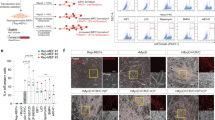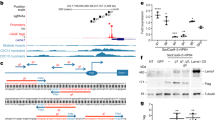Abstract
Gene therapy for Duchenne muscular dystrophy (DMD) will require sustained expression of therapeutic dystrophins in striated muscles. Lentiviral vectors have a relatively large transgene carrying capacity and can integrate into nondividing cells. We therefore explored the use of lentiviral vectors for transferring genes into mouse skeletal muscle cells. These vectors successfully transferred a minidystrophin expression cassette into mdx muscles, and minidystrophin expression persisted and prevented subsequent muscle fiber degeneration for at least 6 months. However, only low to moderate levels of skeletal muscle transduction could be obtained by intramuscular injection of the highest currently available lentiviral doses. Using cultured cells, the lentiviral vectors effectively transduced proliferating and terminally differentiated muscle cells, indicating that cell cycling is not essential for transduction of myogenic cells. We further showed that lentiviral vectors efficiently transduced both primary myoblasts and multipotent adult progenitor cells (MAPCs) in vitro, and the cells persistently expressed transgenes without any obvious toxicity. When mdx primary myoblasts were genetically modified with minidystrophin vectors and transplanted into mdx skeletal muscles, significant numbers of dystrophin-expressing myofibers formed. Finally, we showed that a short, highly active CK6 regulatory cassette directed muscle-specific activity in the context of the lentiviral vectors. The ability of lentiviral vectors to transduce myogenic progenitors using a minidystrophin cassette regulated by a muscle-specific promoter suggests that this system could be useful for ex vivo gene therapy of muscular dystrophy.
This is a preview of subscription content, access via your institution
Access options
Subscribe to this journal
Receive 12 print issues and online access
$259.00 per year
only $21.58 per issue
Buy this article
- Purchase on Springer Link
- Instant access to full article PDF
Prices may be subject to local taxes which are calculated during checkout





Similar content being viewed by others
References
Emery AEH (ed). The Muscular Dystrophies. Oxford University Press Inc.: New York, Oxford, 2001.
Gregorevic P, Chamberlain JS . Gene therapy for muscular dystrophy – a review of promising progress. Expert Opin Biol Ther 2003; 3: 803–814.
Cox GA et al. Overexpression of dystrophin in transgenic mdx mice eliminates dystrophic symptoms without toxicity. Nature 1993; 364: 725–729.
Harper SQ et al. Modular flexibility of dystrophin: implications for gene therapy of Duchenne muscular dystrophy. Nat Med 2002; 8: 253–261.
DelloRusso C et al. Functional correction of adult mdx mouse muscle using gutted adenoviral vectors expressing full-length dystrophin. Proc Natl Acad Sci USA 2002; 99: 12979–12984.
Gregorevic P et al. Systemic delivery of genes to striated muscles using adeno-associated viral vectors. Nat Med 2004; 10: 828–834.
Vincent-Lacaze N et al. Structure of adeno-associated virus vector DNA following transduction of the skeletal muscle. J Virol 1999; 73: 1949–1955.
Schnepp BC et al. Genetic fate of recombinant adeno-associated virus vector genomes in muscle. J Virol 2003; 77: 3495–3504.
Xiao X, Li J, Samulski RJ . Efficient long-term gene transfer into muscle tissue of immunocompetent mice by adeno-associated virus vector. J Virol 1996; 70: 8098–8108.
Snyder RO et al. Efficient and stable adeno-associated virus-mediated transduction in the skeletal muscle of adult immunocompetent mice. Hum Gene Ther 1997; 8: 1891–1900.
Harui A, Suzuki S, Kochanek S, Mitani K . Frequency and stability of chromosomal integration of adenovirus vectors. J Virol 1999; 73: 6141–6146.
Kafri T et al. Sustained expression of genes delivered directly into liver and muscle by lentiviral vectors. Nat Genet 1997; 17: 314–317.
Seppen J, Barry SC, Harder B, Osborne WR . Lentivirus administration to rat muscle provides efficient sustained expression of erythropoietin. Blood 2001; 98: 594–596.
MacKenzie TC et al. Efficient transduction of liver and muscle after in utero injection of lentiviral vectors with different pseudotypes. Mol Ther 2002; 6: 349–358.
Kobinger GP et al. Correction of the dystrophic phenotype by in vivo targeting of muscle progenitor cells. Hum Gene Ther 2003; 14: 1441–1449.
Bischoff R . The satellite cell and muscle regeneration. In: Andrew G, Engel CF-A (eds). Myology. McGraw-Hill Inc., 1994: pp 97–118.
Gussoni E et al. Dystrophin expression in the mdx mouse restored by stem cell transplantation. Nature 1999; 401: 390–394.
Jankowski RJ, Haluszczak C, Trucco M, Huard J . Flow cytometric characterization of myogenic cell populations obtained via the preplate technique: potential for rapid isolation of muscle-derived stem cells. Hum Gene Ther 2001; 12: 619–628.
Jiang Y et al. Multipotent progenitor cells can be isolated from postnatal murine bone marrow, muscle, and brain. Exp Hematol 2002; 30: 896–904.
Bujold M et al. Autotransplantation in mdx mice of mdx myoblasts genetically corrected by an HSV-1 amplicon vector. Cell Transplant 2002; 11: 759–767.
Floyd Jr SS et al. Ex vivo gene transfer using adenovirus-mediated full-length dystrophin delivery to dystrophic muscles. Gene Therapy 1998; 5: 19–30.
Moisset PA, Gagnon Y, Karpati G, Tremblay JP . Expression of human dystrophin following the transplantation of genetically modified mdx myoblasts. Gene Therapy 1998; 5: 1340–1346.
Hartigan-O'Connor D et al. Immune evasion by muscle-specific gene expression in dystrophic muscle. Mol Ther 2001; 4: 525–533.
Cordier L et al. Muscle-specific promoters may be necessary for adeno-associated virus-mediated gene transfer in the treatment of muscular dystrophies. Hum Gene Ther 2001; 12: 205–215.
Hauser MA et al. Analysis of muscle creatine kinase regulatory elements in recombinant adenoviral vectors. Mol Ther 2000; 2: 16–25.
Neville C et al. Skeletal muscle cultures. Methods Cell Biol 1997; 52: 85–116.
Clegg CH, Linkhart TA, Olwin BB, Hauschka SD . Growth factor control of skeletal muscle differentiation: commitment to terminal differentiation occurs in G1 phase and is repressed by fibroblast growth factor. J Cell Biol 1987; 105: 949–956.
Chamberlain JS, Jaynes JB, Hauschka SD . Regulation of creatine kinase induction in differentiating mouse myoblasts. Mol Cell Biol 1985; 5: 484–492.
Jaynes JB et al. Transcriptional regulation of the muscle creatine kinase gene and regulated expression in transfected mouse myoblasts. Mol Cell Biol 1986; 6: 2855–2864.
Naldini L . Lentiviruses as gene transfer agents for delivery to non-dividing cells. Curr Opin Biotechnol 1998; 9: 457–463.
Nguyen TH et al. Highly efficient lentiviral vector-mediated transduction of nondividing, fully reimplantable primary hepatocytes. Mol Ther 2002; 6: 199–209.
Bonci D et al. ‘Advanced’ generation lentiviruses as efficient vectors for cardiomyocyte gene transduction in vitro and in vivo. Gene Therapy 2003; 10: 630–636.
Naldini L et al. Efficient transfer, integration, and sustained long-term expression of the transgene in adult rat brains injected with a lentiviral vector. Proc Natl Acad Sci USA 1996; 93: 11382–11388.
Chen W et al. Lentiviral vector transduction of hematopoietic stem cells that mediate long-term reconstitution of lethally irradiated mice. Stem Cells 2000; 18: 352–359.
Montanaro F et al. Skeletal muscle engraftment potential of adult mouse skin side population cells. Proc Natl Acad Sci USA 2003; 100: 9336–9341.
Bachrach E et al. Systemic delivery of human microdystrophin to regenerating mouse dystrophic muscle by muscle progenitor cells. Proc Natl Acad Sci USA 2004; 101: 3581–3586.
Acsadi G et al. A differential efficiency of adenovirus-mediated in vivo gene transfer into skeletal muscle cells of different maturity. Hum Mol Genet 1994; 3: 579–584.
Nalbantoglu J, Pari G, Karpati G, Holland PC . Expression of the primary coxsackie and adenovirus receptor is downregulated during skeletal muscle maturation and limits the efficacy of adenovirus-mediated gene delivery to muscle cells. Hum Gene Ther 1999; 10: 1009–1019.
Bilbao R et al. Fetal muscle gene transfer is not enhanced by an RGD capsid modification to high-capacity adenoviral vectors. Gene Therapy 2003; 10: 1821–1829.
Guibinga GH, Miyanohara A, Esko JD, Friedmann T . Cell surface heparan sulfate is a receptor for attachment of envelope protein-free retrovirus-like particles and VSV-G pseudotyped MLV-derived retrovirus vectors to target cells. Mol Ther 2002; 5: 538–546.
Cao B, Mytinger JR, Huard J . Adenovirus mediated gene transfer to skeletal muscle. Microsc Res Technol 2002; 58: 45–51.
Flint SJ, Enquist LW, Krug RM, Racaniello VR, Skalka AM . Principles of Virology, Molecular Biology, Pathogenesis, and Control. ASM press: Washington DC, 2000.
Scherr M et al. Efficient gene transfer into the CNS by lentiviral vectors purified by anion exchange chromatography. Gene Therapy 2002; 9: 1708–1714.
Follenzi A, Naldini L . Generation of HIV-1 derived lentiviral vectors. Methods Enzymol 2002; 346: 454–465.
Hartigan-O'Connor D, Barjot C, Salvatori G, Chamberlain JS . Generation and growth of gutted adenoviral vectors. Methods Enzymol 2002; 346: 224–246.
Potter M et al. Streamlined large-scale production of recombinant adeno-associated virus (rAAV) vectors. Methods Enzymol 2002; 346: 413–430.
Blankinship MJ et al. Efficient transduction of skeletal muscle using vectors based on adeno-associated virus serotype 6. Mol Ther 2004; 10: 671–678.
Barry SC et al. Lentivirus vectors encoding both central polypurine tract and posttranscriptional regulatory element provide enhanced transduction and transgene expression. Hum Gene Ther 2001; 12: 1103–1108.
Hawley RG, Lieu FH, Fong AZ, Hawley TS . Versatile retroviral vectors for potential use in gene therapy. Gene Therapy 1994; 1: 136–138.
Miller JB, Crow MT, Stockdale FE . Slow and fast myosin heavy chain content defines three types of myotubes in early muscle cell cultures. J Cell Biol 1985; 101: 1643–1650.
Acknowledgements
We thank Luigi Naldini and William R Osborne for providing lentiviral vector backbones, and James Allen, Paul Gregorevic, and Jay Han for critical reading of this paper. These studies were supported by grants from the National Institutes of Health (AR44533, NS46788, AR18860, and HL64387) and the Muscular Dystrophy Association (USA) (to JSC and SDH). SL was supported by a Research Development Grant from the Muscular Dystrophy Association (USA).
Author information
Authors and Affiliations
Rights and permissions
About this article
Cite this article
Li, S., Kimura, E., Fall, B. et al. Stable transduction of myogenic cells with lentiviral vectors expressing a minidystrophin. Gene Ther 12, 1099–1108 (2005). https://doi.org/10.1038/sj.gt.3302505
Received:
Accepted:
Published:
Issue Date:
DOI: https://doi.org/10.1038/sj.gt.3302505
Keywords
This article is cited by
-
Cell Therapy Strategies on Duchenne Muscular Dystrophy: A Systematic Review of Clinical Applications
Stem Cell Reviews and Reports (2024)
-
Engraftment potential of dermal fibroblasts following in vivo myogenic conversion in immunocompetent dystrophic skeletal muscle
Molecular Therapy - Methods & Clinical Development (2014)
-
Dystrophin Delivery to Muscles of mdx Mice Using Lentiviral Vectors Leads to Myogenic Progenitor Targeting and Stable Gene Expression
Molecular Therapy (2010)
-
Desmin-regulated Lentiviral Vectors for Skeletal Muscle Gene Transfer
Molecular Therapy (2010)
-
Reduction of nontarget infection and systemic toxicity by targeted delivery of conditionally replicating viruses transported in mesenchymal stem cells
Cancer Gene Therapy (2010)



